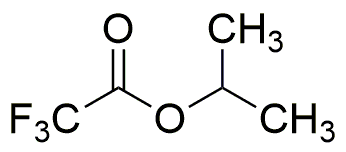Isopropyl trifluoroacetate is widely utilized in research focused on:
- Organic Synthesis: This compound serves as a versatile reagent in the synthesis of various organic molecules, enabling chemists to create complex structures efficiently.
- Fluorinated Compounds Production: It is crucial in producing fluorinated compounds, which are valuable in pharmaceuticals and agrochemicals, enhancing their efficacy and stability.
- Solvent Applications: Isopropyl trifluoroacetate acts as a solvent in various chemical reactions, providing a medium that can dissolve a wide range of substances, thus improving reaction outcomes.
- Analytical Chemistry: This compound is used in analytical methods, such as chromatography, helping researchers separate and identify components in complex mixtures effectively.
- Polymer Chemistry: It plays a role in the development of fluorinated polymers, which are known for their unique properties, including chemical resistance and thermal stability, making them suitable for high-performance applications.
General Information
Properties
Safety and Regulations
Applications
Isopropyl trifluoroacetate is widely utilized in research focused on:
- Organic Synthesis: This compound serves as a versatile reagent in the synthesis of various organic molecules, enabling chemists to create complex structures efficiently.
- Fluorinated Compounds Production: It is crucial in producing fluorinated compounds, which are valuable in pharmaceuticals and agrochemicals, enhancing their efficacy and stability.
- Solvent Applications: Isopropyl trifluoroacetate acts as a solvent in various chemical reactions, providing a medium that can dissolve a wide range of substances, thus improving reaction outcomes.
- Analytical Chemistry: This compound is used in analytical methods, such as chromatography, helping researchers separate and identify components in complex mixtures effectively.
- Polymer Chemistry: It plays a role in the development of fluorinated polymers, which are known for their unique properties, including chemical resistance and thermal stability, making them suitable for high-performance applications.
Documents
Safety Data Sheets (SDS)
The SDS provides comprehensive safety information on handling, storage, and disposal of the product.
Product Specification (PS)
The PS provides a comprehensive breakdown of the product’s properties, including chemical composition, physical state, purity, and storage requirements. It also details acceptable quality ranges and the product's intended applications.
Certificates of Analysis (COA)
Search for Certificates of Analysis (COA) by entering the products Lot Number. Lot and Batch Numbers can be found on a product’s label following the words ‘Lot’ or ‘Batch’.
*Catalog Number
*Lot Number
Certificates Of Origin (COO)
This COO confirms the country where the product was manufactured, and also details the materials and components used in it and whether it is derived from natural, synthetic, or other specific sources. This certificate may be required for customs, trade, and regulatory compliance.
*Catalog Number
*Lot Number
Safety Data Sheets (SDS)
The SDS provides comprehensive safety information on handling, storage, and disposal of the product.
DownloadProduct Specification (PS)
The PS provides a comprehensive breakdown of the product’s properties, including chemical composition, physical state, purity, and storage requirements. It also details acceptable quality ranges and the product's intended applications.
DownloadCertificates of Analysis (COA)
Search for Certificates of Analysis (COA) by entering the products Lot Number. Lot and Batch Numbers can be found on a product’s label following the words ‘Lot’ or ‘Batch’.
*Catalog Number
*Lot Number
Certificates Of Origin (COO)
This COO confirms the country where the product was manufactured, and also details the materials and components used in it and whether it is derived from natural, synthetic, or other specific sources. This certificate may be required for customs, trade, and regulatory compliance.

